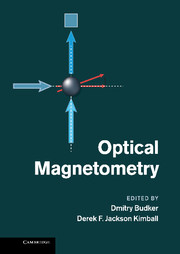Book contents
- Frontmatter
- Contents
- List of contributors
- Preface
- Part I Principles and techniques
- Part II Applications
- 13 Remote detection magnetometry
- 14 Detection of nuclear magnetic resonance with atomic magnetometers
- 15 Space magnetometry
- 16 Detection of biomagnetic fields
- 17 Geophysical applications
- Part III Broader impact
- Index
17 - Geophysical applications
from Part II - Applications
Published online by Cambridge University Press: 05 May 2013
- Frontmatter
- Contents
- List of contributors
- Preface
- Part I Principles and techniques
- Part II Applications
- 13 Remote detection magnetometry
- 14 Detection of nuclear magnetic resonance with atomic magnetometers
- 15 Space magnetometry
- 16 Detection of biomagnetic fields
- 17 Geophysical applications
- Part III Broader impact
- Index
Summary
Airborne magnetometers and gradiometers
Along with electromagnetic (EM), gravity, and radiation detection methods, magnetometry is a basic method for geophysical exploration for minerals, including diamonds and oil. Fixed-wing and helicopter-borne magnetometers and gradiometers are generally used for assessment explorations, with ground and marine methods providing for follow-up mapping of interesting areas.
Magnetometers have been towed by or mounted on airborne platforms for resource exploration since the 1940s [1]. Mapping of the Earth's magnetic field can illuminate structural geology relating to rock contacts, intrusive bodies, basins, and bedrock. Susceptibility contrasts associated with differing amounts of magnetite in the subsurface can identify areas that are good candidates for base and precious metal mineral deposits or diamond pipes. Existing magnetic anomalies associated with known mineralization are often extrapolated to extend drilling patterns and mining activities into new areas.
After World War II fluxgate sensors, originally employed for submarine detection, replaced dipping needle and induction coil magnetic field sensing systems as the air-borne magnetometer of choice. While the fluxgate and induction magnetometers could measure the components of the Earth's field rapidly (100 Hz or faster), their sensitivity to orientation made them a poor choice for installation on moving platforms. Experiments by Packard and Varian in 1953 on nuclear magnetic resonance resulted in the invention of the orientation-independent total-field proton precession magnetometer and total-field magnetometers replaced vector magnetometer systems in mobile platforms.
- Type
- Chapter
- Information
- Optical Magnetometry , pp. 319 - 336Publisher: Cambridge University PressPrint publication year: 2013
- 7
- Cited by

